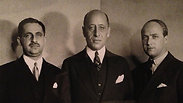
Mel Orbach, a lawyer representing the heirs of Nazi-era Jewish art dealers, filed a lawsuit in the US suing Germany and a German museum for the return of a medieval treasure trove worth an estimated $226 million, which they claim their ancestors sold under Nazi pressure.
The suit, which attorneys said was filed late Monday in the US District Court in Washington DC, is the latest salvo in a long-running campaign by the heirs for return of the so-called Welfenschatz, or Guelph Treasure.
Originally collected over centuries by the Braunschweig Cathedral, the Welfenschatz includes some of the outstanding goldsmith works of the Middle Ages, among them ornate containers in the form of cathedrals used to store Christian relics. Many of the silver and gold pieces are decorated with jewels and pearls. Some are more than 800 years old.
The organization that oversees Berlin's museums, the Prussian Cultural Heritage Foundation, says that the collectors were not forced to sell the pieces, arguing among other things that the collection was not even in Germany at the time of its sale.
Last year, a German government commission created to help resolve restitution claims evaluated both arguments and recommended that the collection stay in Germany. The commission wrote that after thoroughly investigating the sale process, it came to the conclusion that it was not a "forced sale due to persecution."
Complicating matters, the state of Berlin recently declared the collection a national cultural treasure, meaning the art pieces can no longer leave the country without the explicit permission of the country's culture minister.
The Welfenschatz collection, originally 82 pieces, ended up in the hands of a consortium of Jewish art dealers from Frankfurt in 1929 when they purchased it from a Braunschweig duke. With the onset of the Great Depression, they were not able to resell all the relics as quickly and profitably as expected; in the early 1930s they still owned half of the collection.
After Adolf Hitler's rise to power in 1933, the story becomes murky.
What is undisputed is that Jewish owners sold the remaining 42 pieces to the state of Prussia, which at the time was governed by top Nazi Hermann Goering.
The Prussian Cultural Heritage Foundation, which oversees the Berlin museums, has maintained in the past that the price was fair. It notes that the collection was in Amsterdam at the time, though several of the owners still lived in Germany. The Germans did not invade the Netherlands until 1940 -- five years after the sale.
The collection, which has been on display in Berlin since the early 1960s and is on show at the city's Museum of Decorative Arts, is considered the largest collection of German church treasure in public hands.
The Associated Press contributed to this report















